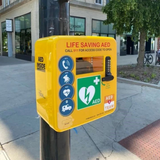What is CPR?
Knowing the basics of first aid and how to deliver CPR (cardiopulmonary resuscitation) can make the difference between life and death. If someone suddenly falls ill, delivering correct CPR can really make all the difference. This blog aims to showcase how to perform CPR and to raise awareness of its importance so that more members of the public know what to do in an emergency.
About CPR
Oxygen is what keeps us alive. Without it, our bodies start to shut down as vital organs cannot survive very long without a constant oxygen supply. When we breathe in, oxygen enters the bloodstream and is circulated around our body by the heart. If the heart stops beating, the body experiences a lack of oxygen, as blood is no longer pumped to vital organs. Fortunately, CPR can help to bridge this critical gap.
CPR is an emergency procedure that restores the flow of oxygenated blood to the body when someone’s heart stops beating. It temporarily takes over the role of the heart and lungs, buying time until professional medical help arrives or a defibrillator can restart the heart. CPR involves chest compressions and, if possible, rescue breaths to manually provide oxygenated blood where it’s needed most.
Chest Compressions and Rescue Breaths
For CPR to be effective, chest compressions and rescue breaths must be delivered correctly:
Chest Compressions
- Place one hand on top of the other and interlock your fingers.
- Use the heel of your bottom hand to press on the sufferer’s chest, at the centre of the breastbone.
- Keep your arms straight and use your upper body weight to push down firmly.
- Push to a depth of 5-6 cm at a rate of 100-120 compressions per minute.
- Songs like ‘Stayin’ Alive’ by the Bee Gees can help you keep the correct rhythm. Remember, these compressions need to be firm to ensure they’re effective.
Rescue Breaths
- Tilt the victim’s head back and lift their chin to open the airway.
- Pinch their nose closed and seal your mouth over theirs.
- Give a normal breath into their lungs for about one second, watching for the chest to rise.
- Repeat for a second breath before resuming compressions.
If you’re unable or unwilling to give rescue breaths, hands-only CPR can still be lifesaving. Focus on delivering continuous chest compressions.
Steps to Perform CPR
As recommended by the British Heart Foundation (BHF), if someone is unresponsive and not breathing normally, follow these steps:
- Shake and shout: Check if they respond to loud commands or gentle shaking.
- Check for breathing: Look for regular chest movements. Gasping or irregular breathing does not count as normal.
- Call 999: Immediately call for emergency assistance, providing as much detail as possible.
- Start chest compressions: Push hard and fast at the centre of their chest.
- Use a defibrillator (if available): Apply the pads and follow the AED’s voice prompts.
- Continue CPR: Alternate 30 compressions with two rescue breaths (if possible) until emergency services arrive or the person starts breathing normally.
If you have no training or cannot deliver breaths, continue hands-only CPR with uninterrupted compressions.
CPR Training
CPR manikins are essential for effective training, allowing participants to practise the correct technique in a safe and controlled environment.
- Realistic Design: Manikins mimic the size, weight, and resistance of a human body, giving learners a realistic sense of what it feels like to perform CPR.
- Feedback Mechanisms: Many modern manikins provide real-time feedback on compression depth, rate, and hand placement.
- Building Confidence: Regular training helps build the confidence needed to act decisively in a real emergency.
By practising with CPR manikins, learners develop the skills and muscle memory required to perform high-quality CPR when it’s needed most.
The Role of Defibrillators
Defibrillators (AEDs) are critical in saving lives during a cardiac arrest. These devices deliver an electric shock to the heart, helping to restore a normal rhythm if necessary.
- AEDs are designed to be simple to use, with audio and visual prompts guiding the user step by step.
- They are now commonly available in public spaces such as shopping centres, train stations, schools, and sports facilities across the UK.
- When used alongside CPR, defibrillators can increase survival rates tenfold, offering the best chance of recovery.
If a defibrillator is available, it should be used as soon as possible while CPR continues. It is designed for use by anyone, regardless of prior training.
Legal Protection for Bystanders
In the UK, the Social Action, Responsibility, and Heroism Act (2015) offers legal protection for individuals who administer CPR or use a defibrillator in good faith. This protection ensures that bystanders can act without fear of legal repercussions, as long as they are genuinely trying to help.
The Chain of Survival
The British Heart Foundation highlights the importance of the Chain of Survival, which includes:
- Early recognition of cardiac arrest and calling for help.
- Early CPR to buy time.
- Early defibrillation to restart the heart.
- Post-resuscitation care by medical professionals.
Every link in this chain is crucial to increasing the chances of survival.
Conclusion
Knowing how to perform CPR and use a defibrillator can save lives. By equipping workplaces, schools, and communities with CPR training, defibrillators, and the knowledge to act, we can create a nation where more people survive sudden cardiac arrest.
At Risk Assessment Products Ltd, we provide state-of-the-art defibrillators and high-quality CPR manikins to support training and emergency preparedness. Visit our website or contact us to learn more about our range of lifesaving products and how we can help you make a difference. Together, we can save lives.
Recent Posts
-
What is CPR?
Knowing the basics of first aid and how to deliver CPR (cardiopulmonary resuscitation) can make the …17th Nov 2024 -
What is a sudden cardiac arrest (SCA)?
Sudden Cardiac Arrest (SCA) is a critical medical emergency where the heart abruptly ceases to funct …17th Nov 2024 -
Empowering Communities: The Lifesaving Impact of CPR on Restart a Heart Day
Every year, on and around October 16th, an important event takes place - Restart a Heart Day. This a …16th Oct 2023




